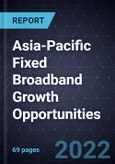Transformative Mega Trends Drive the Growth of Fixed Broadband in Asia-Pacific
Remote working and online learning have transformed the fixed broadband market in Asia-Pacific. These market trends drove up usage of high-data- and high-bandwidth-intensive applications, such as telecommuting, video conferencing and streaming, which increased the demand for high-speed and reliable internet connectivity. However, the growing adoption of digital applications, intelligent connections, and computing devices within the household and enterprise are adding a constraint to the current fixed-line network infrastructure.
Customers, including residential end users, small and medium enterprises, and large enterprises, are experiencing weak performance in network speeds, bandwidth, and coverage. Although the demand for fixed broadband has increased, it has shifted to residential and rural areas, where internet connectivity is expensive, unavailable, or insufficient. Thus, the digital divide in the Asia-Pacific region has widened and is further as a large portion of the region’s population still does not have access to the internet. Accessibility and affordability are the top growth drivers of fixed broadband services.
Service providers are developing new business models and are increasing innovation and investment to address the market challenges and capture growth opportunities. Governments and regulatory bodies continue to play a vital role through their national broadband plans that reduce cost and drive adoption. Consequently, the number of service providers such as mobile network operators, internet service providers, cable service providers, and satellite service providers have increased due to new fixed-line players, open access and wholesale agreements, and rising network alternatives.
Service providers are competing by accelerating the rollout of network infrastructure, such as fiber, fixed wireless access, satellite broadband, and 5G, to meet pressing market demand and capture growth opportunities. They are also offering value-added services, such as SD-WAN and managed network services, and bundled package plans that include content and networking gear. As a result, service providers can drive the migration of customers to higher-tier packages, improve customer experience, and enable revenue growth. Infrastructure sharing, market consolidation, and ecosystem partnership are strategies that can help capture growth opportunities.








